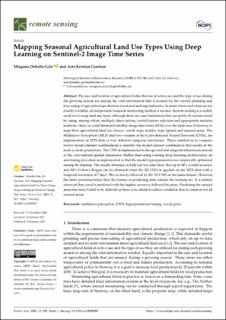| dc.description.abstract | The size and location of agricultural fields that are in active use and the type of use during the growing season are among the vital information that is needed for the careful planning and forecasting of agricultural production at national and regional scales. In areas where such data are not readily available, an independent seasonal monitoring method is needed. Remote sensing is a widely used tool to map land use types, although there are some limitations that can partly be circumvented by using, among others, multiple observations, careful feature selection and appropriate analysis methods. Here, we used Sentinel-2 satellite image time series (SITS) over the land area of Norway to map three agricultural land use classes: cereal crops, fodder crops (grass) and unused areas. The Multilayer Perceptron (MLP) and two variants of the Convolutional Neural Network (CNN), are implemented on SITS data of four different temporal resolutions. These enabled us to compare twelve model-dataset combinations to identify the model-dataset combination that results in the most accurate predictions. The CNN is implemented in the spectral and temporal dimensions instead of the conventional spatial dimension. Rather than using existing deep learning architectures, an autotuning procedure is implemented so that the model hyperparameters are empirically optimized during the training. The results obtained on held-out test data show that up to 94% overall accuracy and 90% Cohen’s Kappa can be obtained when the 2D CNN is applied on the SITS data with a temporal resolution of 7 days. This is closely followed by the 1D CNN on the same dataset. However, the latter performs better than the former in predicting data outside the training set. It is further observed that cereal is predicted with the highest accuracy, followed by grass. Predicting the unused areas has been found to be difficult as there is no distinct surface condition that is common for all unused areas. | en_US |

